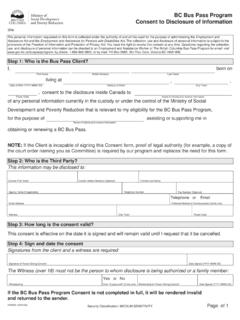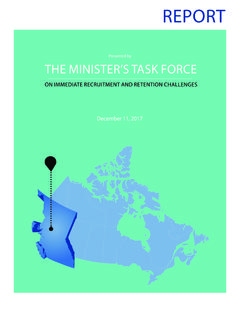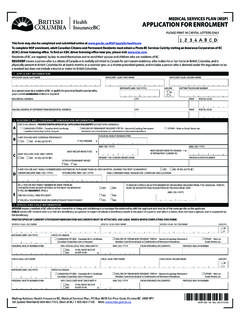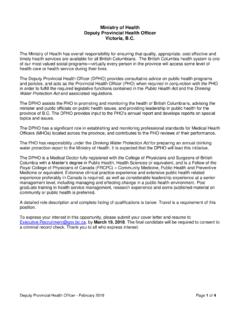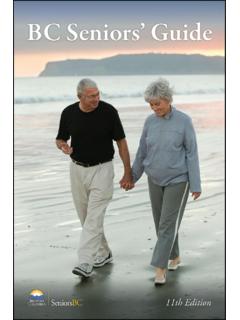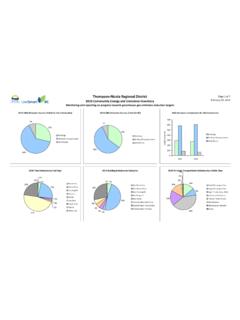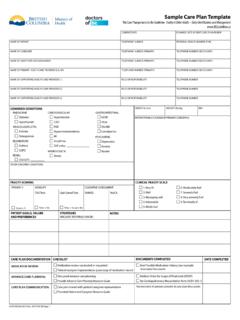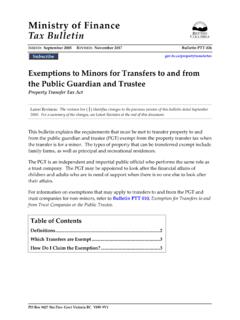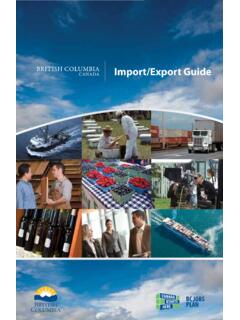Transcription of The B.C. Handbook for Action on Child Abuse and Neglect ...
1 The Handbook for Action on Child Abuse and Neglect For Service Providers JUNE 2017. Helpful Phone Numbers Toll-free: 1 800 663 9122. Your local Ministry of Children and Family Development District Office: Your local Delegated Aboriginal Child and Family Services Agency: Police (Emergency): Police (Non-Emergency): TABLE OF CONTENTS. ABOUT THIS Handbook .. 5. Purpose .. 6. Organization .. 6. Glossary .. 7. WORKING TOGETHER .. 11. Roles and Responsibilities .. 11. Ministry of Children and Family Development .. 11. Delegated Aboriginal Child and Family Services Agencies.
2 11. Police .. 12. Service Providers .. 13. Legislation, Principles and Protocols .. 13. Legislation .. 13. Child , Family and Community Service Act .. 13. Criminal Code of Canada .. 14. Principles .. 14. Protocols .. 15. Protocols Between and Among Organizations .. 15. Protocols and Guidelines Within Organizations .. 16. Information Sharing .. 17. Legal Basis for Collecting and Sharing Information .. 18. Summary of Roles and Responsibilities .. 19. RECOGNIZING Child Abuse AND Neglect .. 23. Defining Child Abuse and Neglect .
3 23. Physical Abuse .. 23. Emotional Harm .. 23. Sexual Abuse .. 24. Sexual Exploitation .. 24. Neglect .. 25. What to Watch for .. 25. Disclosures of Child Abuse or Neglect .. 25. Direct Disclosures .. 25. Indirect Disclosures .. 26. Indicators of Possible Child Abuse or Neglect .. 26. Possible Indicators of Physical Abuse .. 27. Possible Indicators of Sexual Abuse .. 27. Possible Indicators of Emotional Harm .. 28. Possible Indicators of Neglect .. 28. Possible Indicators of Failure to Thrive .. 29. When Should I Call a Child Welfare Worker?
4 30. RESPONDING TO SUSPECTED Child Abuse AND Neglect .. 37. Talking with the Child or youth .. 37. When a Child or youth Discloses Abuse or Neglect .. 37. When There are Indicators of Child Abuse or Neglect .. 39. Reporting Suspected Child Abuse or Neglect .. 40. Duty to Report .. 40. Failure to Report and Making False Reports .. 41. Circumstances That Must be Reported .. 41. A Child or youth Living in a Domestic Violence Situation: .. 42. How to Contact a Child Welfare Worker .. 43. What to Report to the Child Welfare Worker.
5 43. When to Call Police .. 44. When to Notify Other Authorities .. 44. High Impact or Multiple Victim Cases .. 45. If You Suspect Child Abuse or Neglect by a Service Provider .. 45. What Happens After You Make a Report .. 47. Your Role .. 47. The Child Welfare Worker's Role .. 47. Receiving the Report .. 47. Assessing the Report .. 47. If the Child or youth is at Immediate Risk of. Harm .. 48. Determining the Least Disruptive Response to Keep the Child or youth Safe .. 48. Family Development Response .. 50. youth Service Response.
6 50. The Investigation Process .. 50. Protecting the Child or youth .. 51. The Role of the Police .. 51. When a Child or youth is in Immediate Danger .. 52. Where a Criminal Offence May Have Occurred or is About to Occur.. 52. Arranging for Medical Forensic Evidence .. 53. Involving Victim Services Programs When a Criminal Offence is Suspected .. 54. Victim Service Workers .. 54. Benefits for Victims of Crime .. 55. Victim Safety Notifications .. 55. FOR MORE INFORMATION .. 59. Report Your Concern .. 61. About This Handbook As a service provider, you have a key role to play in helping to keep children and youth safe, and this Handbook can help.
7 If you have reason to believe that a Child or youth needs protection under section 13 of the Child , Family and Community Service Act you must promptly report the matter to a Child welfare worker. (See page 41 for section 13.) Phone 1 800 663-9122 at any time of the day or night. If the Child or youth is in immediate danger, call 9-1-1. or your local police. If you are a Child or youth and would like to talk to someone call the Helpline for Children at 310-1234. You do not need an area code. You can call at any time of the day or night and you do not have to give your name.
8 ABOUT THIS Handbook . All of us families, communities and service providers share responsibility for the safety and well-being of British Columbia's children and youth . That means we must all work together and, if we are concerned about the safety and well-being of a Child or youth as outlined in section 13 of the Child , Family and Community Act (CFCSA), we must report the concerns to a Child welfare worker. The United Nations Convention on the Rights of the Child , to which Canada is a signatory, requires us to provide special protection and assistance to children and youth to enable them to reach their full potential as adults.
9 While parents are primarily responsible for ensuring a Child 's or youth 's rights are upheld, government and community also have an important role to play in protecting children and youth . For example, article 19 of the Convention requires government to take all appropriate measures to protect children and youth from Abuse and Neglect while in the care of the parent or legal guardian. As a service provider, you have a key role to play in helping to keep children and youth safe, and this Handbook can help. A. companion guide entitled Responding to Child Welfare Concerns: Your Role in Knowing When and What to Report is available for the general public, to help ensure that all British Columbians are able to recognize and take Action on suspected Child Abuse and Neglect .
10 Both publications are available online. children/reporting- Child - Abuse Most children and youth grow up in safe, secure families, but others need our help. And anyone with reason to believe a Child or youth needs protection under section 13 of CFCSA, has a legal duty to report that concern. That is why it is so important to know the warning signs of Child Abuse and Neglect , and to take the right Action when we see them. Handbook for Action on Child Abuse and Neglect 5. Purpose This Handbook is designed to support an integrated, collaborative response to Child Abuse and Neglect by: Providing information about identifying and reporting suspected Child Abuse and Neglect .
